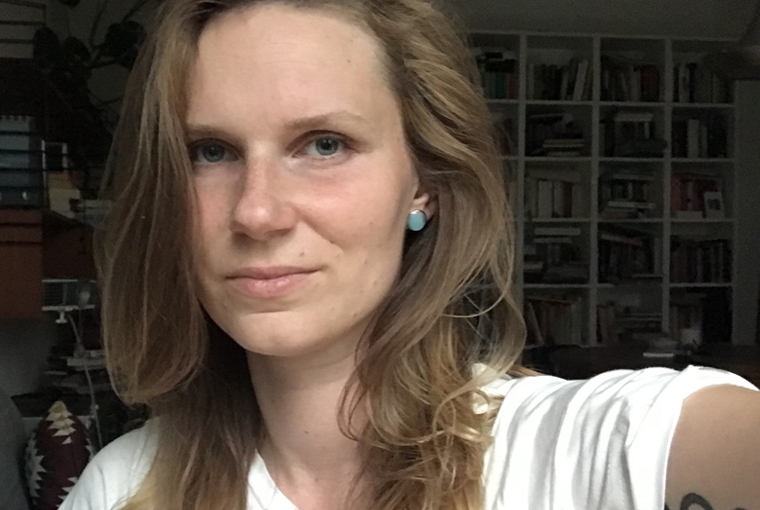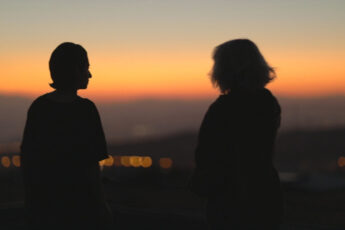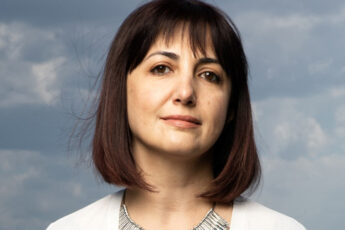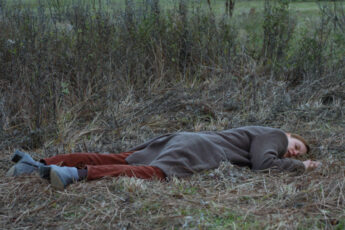
We met Polish filmmaker Ola Jankowska during the 19th Golden Apricot Yerevan International Film Festival (July 10-17) to discuss her fiction debut. We spoke about the process behind making her film, Warsaw in winter, disconnectedness, and new ways of making cinema against all odds.
I wanted to begin by asking you about the initial idea of Anatomy. Where did the story come from and how did it develop?
I think it was two things, one was a more philosophical question that was present in my life at the time – the problem of identity, what makes me me, that was very important. And while I was thinking about that, someone told me that her father had had an accident and started to forget her. And when I heard that story, it really clicked with my question. It made me think about how we spend so much time trying to build who we are, but actually so much of it depends on chance and on circumstances. I think this is where the story came from, but I was also not exactly sure what it would look like in the end. I began writing some loose scenes which were slowly growing into the story that we have now.
So there was actually this personal background to your film…
Yes, but not personal in the sense of autobiographical. It was a story that happened to someone that I know.
As you said, it’s a film about memory and identity. At times it feels like a portrait of our generation as well, especially young women who live in between different cultures. I was wondering which role these topics play for you, memory on the one hand and the more social dimension on the other?
For sure, identity was the starting point, and then the film started evolving and became much more about memory and time – and about the dynamic between presence and absence. The question of our generation was very much present for me; young people, a little bit lost in between different spaces and different cultures. It was probably my goal to take these different elements to create a kind of fragmentary, uncertain portrait.
This leads us to my next question, which is exactly about this fragmentary collage of disparate material, including digital and archival footage and infrared shots. Could you tell us something about your material and how it came together in the editing process?
Almost from the beginning I knew that the film would be composed of these elements. I had already written that in the script. But it was also evolving and infrared, for example, only came in at the end, I didn’t know it would be in the film. I felt that the film needed archival footage to achieve this more social portrayal of a place, so it was added at the editing stage. But the editing was really difficult, because when I wrote the script, it was much easier to jump from one thing to another without big confusion or disruption. However, when we started editing, this act of jumping from one thing to another felt much more confusing. It was a really difficult balancing act and in the end the film turned out less fragmentary than I wanted it to be because it was becoming too emotionally disruptive to have all those different rhythms. Therefore, I decided in the end that it’s better to have an emotion that builds up rather than too much confusion.
What also struck me was the city itself, as this alienating space in grey and blue. Did you plan to have this stylized environment?
No, this was simply a result of shooting in Warsaw in November. It actually looks like this. Initially, I wanted the film to be more colorful. I wanted to capture a city that is kind of hypnotized, a city that is not observed in its actual real time, but a city that is captured in between moments. And trying to achieve this with the surroundings that I was working in actually became – and I only realized this very late – quite alienating, oppressive almost. This wasn’t exactly my intention, but films take on their own life and that is what it is. But I definitely wanted to capture the city, the relationship of the character to her space was very important to me. And I saw this space more as a place that is in transformation; all the time, you see something new being built. I kind of wished it had a bit more color, but that is the truth about this place. That is what it looks like… We spent a long time with the cinematographer walking through the city and searching for locations, a very long time! And that’s how we captured it.
Throughout the film, we’re very close to the main character. And I realized that there’s a certain way of acting manifest in your film, a way of acting that is very much related to the title, “Anatomy”, a story told through these bodies and gestures. We often see these bodies from behind, but not their faces. Is this something which came out of the process of working with the actors?
I think it was very much the work with all actors, but of course especially with the main actress. I was interested in creating a sense of presence rather than showing emotions, showing acting, showing what she feels, showing what she’s going through. I wanted the viewer to be with her -somehow. To be a companion. So we did a lot of rehearsals but not scenes. We did very minimal things to just come to this very simple way of being together in a much more documentary way, so to say. I really wanted to achieve this effect, because that’s what I found more interesting in general: capturing the actor’s presence and not necessarily a dramaturgic kind of fiction.
The sound really contributes to this atmosphere as well. You didn’t use music or very intrusive background sounds, but still certain sounds seem amplified or distorted. Maybe you can tell us a bit more about that?
We worked on the sound for a long time, actually the process took as long as editing itself, which is unusual. I think we really tried to create a feeling which is very close to reality, but which at the same time it is not a generic documentary sound. It was a very focused sound somehow, and it was a very, very long process to create every sound in the film. And we experimented a lot because I wanted the film to be a bit of a hypnotic journey, but still very close to reality. Everything that felt too imposed was wrong but, at the same time, if there was nothing it was too boring. So we were all the time trying to find this feeling of looking at reality while also having this reflective moment of looking at reality.
And there were a lot of mirrors, surfaces, windows, a strange kind of doubling in your film…
Probably, I didn’t even notice. I guess it comes from my interest in identity, but I didn’t consciously introduce all these elements. I think it was probably natural that I wanted the character to somehow look either at herself or look for us to question what is real.
The other thing is the pace, it’s very slow, a kind of meditative, hypnotic journey. Were there any particular films or directors that had had an impact on you at the time?
Well, I think the pace emerged from this question of reality; the acting is not about showing, and for me it was then also the question of real time. In real time, things are not sped up, conversations are not cut like in a film, you know, omitting all the boring parts where nothing happens. I wanted the viewer to enter this world and be there. That requires a certain rejiggling of our natural pace because the pace we live in is fast, but I’m not sure whether it’s actually so natural. So the pace came from that, but it’s true, I have a very high tolerance for slow films. For sure, most of the films that I really love are quite slow. At the time, I was watching Carlos Reygadas and a lot of Asian cinema, such as Edward Yang and Apichatpong Weerasethakul. And I actually watched quite a bit of Angela Schanelec at the time – I don’t know whether they were ‘inspirations,’ I think it’s just what I’m interested in.
Did you shoot during the pandemic?
Yes, we shot during the pandemic. The shoot was stopped by lockdown, and we resumed and stopped again and resumed again, so it was a really weird time. Pandemic or not, I think a lot of our suffering comes from disconnection, also generationally, if we are speaking about social commentary. I feel that’s quite an important thought to me as an observation of where we are at as a society: that most of our suffering actually comes not from actual pain but actually from the inability to even connect with ourselves; there’s not the space, not the time, not the social circumstances to do that – let alone connect with other people. But I like to think that in the end the character in my film does find this connection with herself, this courage to do that, to connect with painful places and with that comes a certain relief as well.
Another thing which interests me is your relation to Polish cinema. In the last couple of years, I noticed so many young female filmmakers from Poland, more than probably in any other European country. I’m thinking, for instance, of Aga Woszczyńska, whose Silent Land is very different from your film, yet there is something like a generational shift happening – would you agree with that?
I know Aga very well, she’s a friend of mine, so of course we used to influence each other when we were at film school [in Łódź] together. There is definitely this trend, and it is especially female filmmakers, there really is a lot of us! I don’t relate to the Polish tradition so much, or at least what is considered the Polish tradition, the old school, such as Andrzej Wajda. I don’t feel very close to that. But there is this new force for sure, there is a sense of something changing in the last five or ten years or so. I don’t live in Poland, but I used to live there for some time. It’s always hard to identify yourself with a group; we don’t have a collective, even though that would be nice. I’m actually dreaming to have this kind of set-up, this collective force of supporting each other. But you’re right, I also see this shift happening.
As different as the individual expressions of this collective force are, there’s also something which to me is “female” cinema. I can’t really describe it other than referring to it as a kind of body-cinema, a cinema of subtle details and gestures…
Yes, that’s so true, it’s something that interests me, although I don’t have anything smart to say about it – but I have noticed in recent years that the films I actually like were made by women. And that wasn’t a political agenda, it was just how I responded to them emotionally, also to a lot of films that are very different from mine, by Kelly Reichardt, Alice Rohrwacher, and of course Claire Denis or Angela Schanelec. I do feel that there is a different way of seeing the world. The body, the details, the lack of a very strong goal that needs to be achieved. I haven’t really thought about that theoretically, but I have noticed it. There’s also a different way of storytelling. And I don’t think it should be undermined. I think the classical approach, classical cinema as you would define it, is the result of a very ‘masculine’ approach, a ‘masculine’ way of thinking and of perceiving reality.
That’s super interesting, thinking that your key rule of how to write a successful script – to have an obstacle and overcome it – this drive, is something that we can break with and that many directors have abandoned in the past years, creating new ways to use the tools we have in cinema.
I actually remember when I was at some workshop while developing Anatomy. There were other projects, and someone noticed that all the female projects were being criticized by the mentors, who were all men. And this person – a guy actually – said, “Oh, isn’t it interesting that all the projects we criticize for different reasons are written by women?” And I thought to myself, yes, it’s actually true because those projects didn’t have that drive; they worked differently. So it’s interesting for sure that there is a different way of making films, even if we don’t call it ‘masculine’ or ‘feminine.’ Of course, it does not have to be gender-related, but there is a certain shift that I noticed as well.
If we think of Kathryn Bigelow, you could argue she makes the most ‘masculine’ films you can imagine…
Yeah, exactly! It’s not about gender, it’s more about what is archetypically considered ‘feminine’ or ‘masculine.’ I quite like this. Actually, I think some years ago I would feel a bit apprehensive about ‘female cinema,’ or it would feel a little bit like an offense somehow. Female cinema as a separate category that is not on par but at the margins – now I kind of feel like, yeah, I’m happy to be there.
On that note, my last question concerns what’s next after Anatomy. Are you already working on another project?
I haven’t decided yet, I have a few ideas that I’m working on now. But I think it will be about women. And I think the project that I take on next explores a certain concept of sacrifice, of gift and love – this idea of giving freely in a capitalist world full of exploitation, where you need to protect yourself and set strong boundaries. I’m very interested in that. I have this character in mind who is willing to give, and I’m interested in how that process of giving shifts her whole environment. I think this is something I find exciting: the dynamic between exploitation and something which I used to call sacrifice. But in a way sacrifice is also a form of exploitation. If you give freely, it is only because you have enough of something. You are not doing it against yourself. In the context of women, I find that very interesting because women are subjected to this dynamic so much. There’s always so much talk about how not to give, how not to sacrifice yourself, and I’m very interested in subverting this and seeing what we can take from this idea, if we are actually willing to give to each other rather than living in a world where everyone has to fight for keeping what they have.
Thank you for the interview.




Leave a Comment